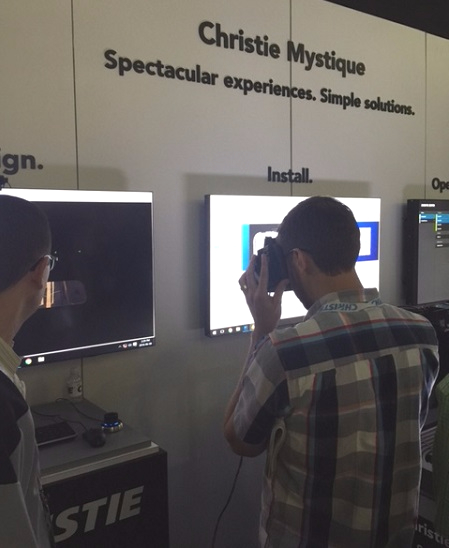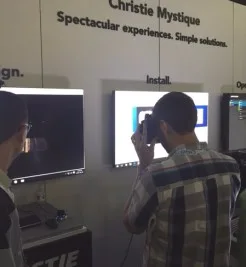As an educational technology director for 25 years, with a significant track record in large educational technology and AV purchases, I have a keen eye for the application of emerging technologies that might transform the ed market landscape. Enter virtual reality. It’s a red hot topic. Given the recent hubbub that is usually associated with virtual reality nowadays, I was surprised to find a subdued presence for VR at InfoComm 2016.

In fact, the VR presence may have been a bit smaller than in previous years at InfoComm, if memory serves me well. I was expecting more from the VR meme at InfoComm 2016, but I didn’t get it.
Besides having fewer VR exhibitors than in past years, the types of VR applications on display had very little connection with the education market. So I am forced to extrapolate—to infer—some possibilities for educational VR from the limited scope of what I saw. Here’s the rundown:
Stampede offered a “wild west” shootout corral. The popular corral experience, run by staffers from VRstudios, showcased their multiuser wireless virtual reality solution. Although they expressed no interest in the educational market whatsoever, feverishly grinning instead about the bullish gaming and entertainment market, See this video: I envision three implications for the ed market: 1) the wireless capabilities make a lot of sense for the ‘freedom’ demanded by the education market: (tethered products don’t do as well, historically); 2) the multiuser nature of the VRstudios technology is an advantage, bringing cooperative learning to virtual reality. (Imagine an entire class meeting on the surface of Mars to learn about gravity, survival, and the challenges of exploring the planet with a mobile rover); and 3) as it stands, this will make teachers and children sick. It made me sick, and that never happens. (They need to figure this one out: see my article, “I love VR; I hate VR.” Here are some videos for your viewing:

In an interesting twist, Christie showcased their Mystique suite of virtual reality-assisted design tools. (I wonder: did they know that Mystique is the beautiful shapeshifter in the X-Men comic series? Oh, well.) The demo was tucked deep in the bowels of the Christie booth experience, and was hard to navigate to, so I imagine that not many people saw it. Still, their design tool was interesting, because it represents Christie’s venture into software solutions, not just hardware solutions. Implications for the ed market: VR can make inroads in education as a tool to solve problems not only in design, but also in visualization (before and after views), simulating dangerous experiments or conditions, or conducting historical “what ifs.”
Canon physically involved passersby in their interactive Eye 2 Eye VR dance and motion experience, which was quite impressive at first glance. Implications for the education market: this technology could eventually evolve into an interactive environment that would be extremely motivating for physical education. I know… it’s a stretch.
One type of virtual reality actually drew educators to their booth: 360° cameras. I observed many educators trolling for solutions that would enable students to create 360° video and virtual realities. It appeared that the Nokia Ozo booth and the Kodak booth had significant traffic in the small InfoComm virtual reality/streaming arena, while Ricoh garnered considerable attention with their Theta camera. Implications for the education market: educators are not shy about exploring the potential of user-generated content.
Analyst Comment
Although InfoComm 2016 offered little overlap this year to the world of education, the time I spent foreshadowing what is possible is instructive. For now, most of the VR companies at InfoComm (camera companies excluded) indicate that education is not on their short-term market horizon. And most educators feel that virtual reality is just too impractical, experimental, and expensive. –Len Scrogan

